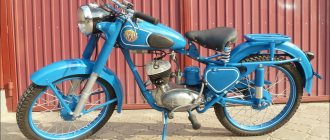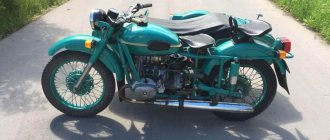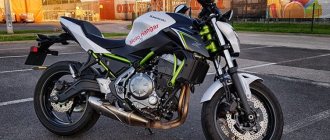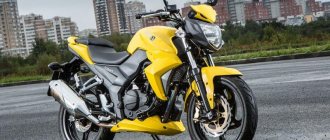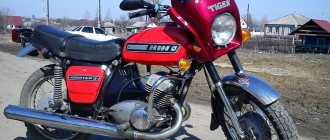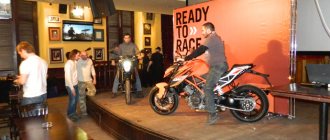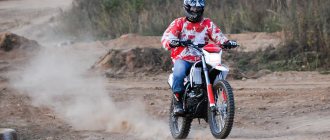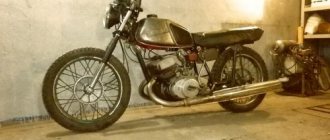Many Soviet motorcycles had an outdated design, but not the Izh Planet Sport. Modern and technologically advanced by the standards of those years, it was produced a good half century ago, and it was highly valued not only in the Soviet Union, but also in other countries where this model was exported. Even after production ceased, Izh Sport was raced by motorcyclists who knew full well that this bike was head and shoulders above most of its contemporaries. And this despite the fact that it cost about a thousand rubles - a huge amount at that time, considering that some engineer received about 100-120 rubles a month.
Design
Developed in 1974, the bike had an original appearance, and was very reminiscent of Japanese motorcycles of that era. A single-level seat, a massive headlight with an integrated speedometer, an elongated gas tank with plastic linings to protect the paintwork from contact with the knees, an impressive chrome exhaust – a classic! But in the case of Izh Planet Sport, technical characteristics were still the main reason for the popularity of the model. Stylish design is good, but design will not take you across the vast expanses of the USSR without any problems.
Engine Izh Planet Sport
The design of the power unit was very progressive for its time and made it possible to obtain high power (32 hp) from a working volume of 340 cubic meters. see. Its main features include:
- Cylinder, with a sleeve made of special cast iron and a jacket made of aluminum alloy. It was attached to the crankcase using four studs.
- A cylinder head with a hemispherical combustion chamber. A spark plug and a decompressor were screwed into the GC, simplifying the starting process.
- A three-channel purge system that improved the filling of the cylinder with the working mixture.
- One-piece crankshaft supported by two roller (No. 2505) and one ball (No. 304) bearings.
- Needle bearings in the upper end of the connecting rod.
- Separate supply of engine oil, which entered the intake tract from a separate tank. The pressure in the lubrication system is controlled by a pump driven by the crankshaft.
It is obvious that the developers of Izh Planet Sport paid special attention to the design of the engine and its maintainability, understanding how important the technical characteristics of the power unit are for a car of this class. However, more than thirty years after the end of production, owners of motorcycles of this model have certain problems.
Specifications
Most of the Izh Sport components were produced in the USSR, although some parts were imported: Japanese Mikuni carburetor , Hungarian optics from Pannonia , Italian Veglia Borletti speedometer and some other little things. The technical characteristics of the Izh Planet Sport 350 were excellent; the thrust-to-weight ratio of the motorcycle was almost twice that of the super-popular Jawa 350, providing acceleration from 0 to 100 km/h in 11 seconds! The motorcycle was so reliable that there were rumors among Soviet bikers that it was originally developed exclusively as an export model. The service life of the CPG, according to reviews, reached 50-60 thousand kilometers, which is a record for a 2-stroke engine. The maximum speed of the Izh Planet Sport is 140 km/h .
Engine
On the Izh Sport in the first years of production, the power reached 32 horsepower , but later it was reduced to 28 hp. for the sake of efficiency and engine life (volume - 340 cm³). The separate lubrication system and engine mounting on rubber mounts implemented in this model were original innovations, thanks to which the bike successfully competed with Japanese and European models in the markets of Great Britain, Finland and other countries. Excellent engine performance combined with high build quality made this bike incredibly popular.
Transmission
The bike is equipped with a classic 4-speed gearbox , simple and reliable. Gears change in the usual manner, 1-N-2-3-4. The gear ratio of the top, fourth gear is 1.0, and you can safely switch to it already at 70 km/h - it will ensure smooth acceleration.
Chassis and brakes
Despite some innovative solutions, the Izh Planet Sport characteristics corresponded to its time. That’s why the motorcycle got a regular, welded frame , and the fork is a simple rodless telescope with a free play of 150 mm. At the rear there is a swingarm with a stroke of 95 mm, so the suspension cannot be called soft. The brakes are drum brakes , not very effective, and the declared stopping distance at a speed of 60 km/h is at least 16 meters .
Electronics
The electronic content of this model was partially imported. Thus, the sound signal was produced at the Japanese company Nikko , the ignition switch was borrowed from Jawa, original Magneti Marelli spark plugs came to the Soviet Union from sunny Italy, and no less original batteries came from the Land of the Rising Sun. But in general, the electrical circuit of the motorcycle is simple and easy to understand.
Weight and dimensions
The dry weight of Izh PS is only 135 kg . Thanks to this, the bike has good dynamics and does not forbid some recklessness, which, in fact, is why Soviet motorcyclists fell in love with it. Its dimensions are appropriate; this model is more compact than Izh Jupiter 5 or Planet 3.
Controllability
For bikers accustomed to modern motorcycles, riding an Izh PS may seem unusual. The bike handles well, but the steering angles are wide and you can easily drop the bike, especially when turning at low speed. This feature is worth keeping in mind.
Fuel consumption
Although the declared fuel consumption does not exceed 3.5 liters at a speed of 50 km/h, during control measurements in normal mode it is about 6 liters . When driving off-road, it can be even higher, but the 14-liter gas tank is enough even for long trips.
The Izh Planet Sport engine prefers gasoline with an octane rating of at least 93, but in fact you can safely fill in AI-92 purchased at a trusted gas station.
Design and production features
The domestic industry was not able to provide the manufacturer with components of the required quality, and their supplies from abroad were very difficult. For several batches of cars from early years of production, we managed to purchase foreign-made components. The lucky ones who purchased Izh Planet Sport in 1974 - 1976 received at their disposal cars equipped with:
- Japanese electronic and electrical components.
- The headlight optics are from Pannonia or Hella, and for countries with left-hand traffic - Lucas.
- Spark plugs PAL or Magneti-Marelli.
- Foreign-made batteries.
All this allowed not only to improve the parameters of the machine, but also to ensure a high weight standard. As already noted, the early modifications of the Izh Planet Sport weighed only 135 kg, and the power output was 237 liters. With. for 1 ton. For comparison, the same figure for JAWA 350/634 reached only 141 hp. With.
As a result, the Izhevsk plant model accelerated to hundreds in less than 11 seconds, and the real maximum speed of the Izh Planet Sport was significantly higher than the 140 km/h indicated in the passport. Despite the impressive dynamic qualities and the “sport” prefix in the name, the new generation Izh Planet was a road motorcycle.
Its landing allowed it to travel long distances, withstanding the hardships of Russian off-road conditions. True, there was an unpleasant drawback. When the rider was too light, the front fork fluttered when accelerating at high speeds. If the rider had sufficient weight or if there was a passenger behind him, this effect was not observed.
Repair and tuning
Thanks to its simple design, all service operations with Planet Sport can be done independently. But some original units are now almost impossible to find, and those rare specimens that can be bought second-hand are often very expensive. But this is the only option - who will buy a rare motorcycle and install Chinese spare parts on it?
Repair
Repairing Planet Sport is not difficult. If you've already seen at least one Soviet bike, then you've seen them all. Despite some differences from its peers in the model range, understanding the design is not difficult. The Izh Planet Sport motorcycle has technical and other characteristics that correspond to the spirit of its time, and there is nothing overly complicated about it.
Spare parts
Spare parts for Planet Sport are difficult to obtain. The IzhMash plant stopped producing them decades ago, and some components were imported from other countries, so now it makes sense to look for them on sites like Avito or on the forums of Izh motorcycle owners. But get ready to shell out some money - rare original units are usually expensive, and you still have to look for them anyway. In some cases, it is possible to replace it with a non-original one, but rarely. In Planet Sport, almost everything was developed from scratch in the USSR, so there are simply no analogues, although some spare parts are suitable from Japanese motorcycles of that era.
Tuning
In Soviet times, it was relatively popular to increase the working volume of an engine cylinder by boring it, and the donor of the piston group was usually the Czechoslovakian CZ 514. They resorted to such an operation infrequently - the Izh Planet Sport 350 technical characteristics are already quite good, and such tuning sharply reduced the engine's life. Nowadays there is no point in tuning at all, since motorcycles restored to their original condition are valued, and not copies tortured by “collective farm tuning”.
Differences by year of production
Changes were constantly made to the design of the motorcycle. Some were associated with the desire to improve technology. Others were caused by demands from industry management to reduce production costs. Raising the price of Izh Planet Sport 350 above 1000 rubles was not allowed by the prices set for competitors’ products.
For example, JAWA 350/634 cost 1080 rubles, and CZ-350 – 980 rubles. To make the picture clearer, we will indicate the main changes, dividing them by year:
- 1975 The front fork was lengthened by 2.5 mm, changing the size of the corrugations installed on it and the upper yoke. Instead of a cylinder head with fan fins, the Izh Planet Sport engine receives a GC with more conventional, linearly arranged cooling fins. Switches and a number of electrical components, although they remained imported, were from another manufacturer. The Mikuni AEX carburetor was gradually replaced by the Mikuni VM32-89 carburetor. The thickness of the spokes was increased (from 3.5 to 4 mm) and the wall thickness of the front brake drum.
- 1976 Instead of foreign-made headlights, they use domestic ones, FG137. The situation is similar with the speedometer. If previously the motorcycle was equipped with a part from Pannonia T5, now it is being replaced by the domestic modification SP-102. Shock absorbers no longer have top covers. The end of the muffler pipe is bent upward. The design and fins of the cylinder are slightly changed.
- 1977 The motorcycle is fully equipped with domestic outdoor lighting devices. The shape of the rear wing changes. The design of the engine crankcase is changing. Specifically, the mounting points, since the power unit begins to be rigidly attached to the frame, abandoning the shock-absorbing rubber bushings. The new type air filter now occupies the entire seat space, which is why the voltage regulator relay is moved under the fuel tank. The main characteristics of Izh Sport remain at the same level.
- 1978 The Mikuni carburetor gives way to the domestic model K62M. Of the imported electrics, only Japanese turn signals remain. An anti-theft lock appears.
- 1979 Replacement of the SP102 speedometer with SP102A and Japanese turn signals with domestic ones (only for the domestic market). The pendulum is extended by 480 mm. Accordingly, the base of the motorcycle increases (up to 1440 mm) and its overall length (up to 2150 mm). The weight of the Izh Sport also increases, reaching 155 kg in this modification.
- 1980 The speedometer cable and gearbox are made not to fit a blade, as before, but to fit a square. The intake design is slightly modified. The lids of tool boxes now feature aluminum nameplates rather than stickers.
During the production process, the Izh Planet Sport motorcycle underwent such a significant number of changes that this could not but affect its characteristics. The installation of a domestically produced carburetor led to a noticeable deterioration in the technical characteristics of the engine. Power decreased from 32 to 28 hp. With.
The adjustments made to the design are also associated with discrepancies in the sources answering the question of how much the Izh Planet Sport weighs. Dry mass indicators range from 135 to 155 kg. It is not surprising that fans of two-wheeled vehicles especially value cars from the first years of production.
They are better manufactured and equipped, and have higher dynamic characteristics. At the end of production, the Izh Planet Sport passport indicated the speed was not 140, but only 135 km/h. Fuel consumption has increased.
Motorcycle modifications
There was only one main factory modification of the Izh Sport, on the basis of which several specific subtypes of the motorcycle were made - for cross-country races, for long trips over rough terrain and for ice racing. The first is popularly called Izh PS Cross, although the correct name is Izh K-15. The enduro version is called Izh M-15. Both are now very difficult to find for sale in decent condition.
But the existence of the Izh Planet Sport 500cc is just a widespread myth. People often tell stories that the IzhMash plant produced a 500 cc limited version, but this is not true. Garage craftsmen sometimes bored the engine to increase volume by installing pistons from CZ, but even in this case the volume did not reach 500 cm³, since the cylinder walls were too thin to allow such boring. The existence of the “reborn” Izh Planet Sport 2 with a 650 cm³ Rotax engine from BMW also belongs to the realm of myths. This “duck” with fake photos at one time alarmed the Internet, but, as it turned out, it was just someone’s joke.
Repair dimensions of the Izh Planet Sport piston
If today a legendary motorcycle reaches a new owner in unsatisfactory condition, it will not be easy to repair it. Engine repairs raise the most questions on Izh Planet Sport. Initially, the resource of the power unit was small and amounted to about 30 thousand km. mileage
True, the manufacturer provided the possibility of boring the cylinder. Initially, the engine was equipped with pistons with three marking options and some differences in size.
| Factory marking | Cylinder diameter, in mm. | Piston diameter, mm. |
| A0 | 76,02 (+0,01) | 75,99 (+0,01) |
| A1 | 76,01 (+0,01) | 75,98 (+0,01) |
| A2 | 76,00 (+0,01) | 75,97 (+0,01) |
Taking into account the boring of the cylinders to the repair size, repair pistons were produced:
| Factory marking | Cylinder diameter, in mm. | Piston diameter, mm. |
| R | 76,5 (+0,06 -0,06) | 76,5 (-0,03) |
| P2 | 77,0 (+0,06 -0,06) | 77,0 (-0,03) |
Today it is extremely difficult to purchase a piston of repair sizes. Even new piston rings are in short supply. A possible way out of the situation is to install compression rings for the VAZ-2101 engine. You have to adjust them to the size of the piston and cut out semicircular recesses at the joint of the lock for the fixing pin.
Advantages and disadvantages
The advantages and disadvantages of innovative technology are always clear. The PS model, which has always been expensive and expensive to maintain, did not escape this fate.
Advantages
- Excellent acceleration dynamics .
- Solid range , up to 300-350 km with quiet driving on the highway.
- resource for a 2-stroke engine .
- Excellent reliability is a rare quality for Soviet motorcycles.
Flaws
- Weak drum brakes .
- The difficulty of finding spare parts and consumables in our time, as well as their high cost.
- It is difficult to find a copy in good condition and without “collective farm” tuning.
History of equipment features
1974
- The first option for mounting the engine is soft, with rubber dampers
- Special “fan” fins of the cylinder head
- Carburetor "Mikuni" AEX (Japan)
- Initially installed domestic direction indicators (from the base Planeta-3 and Izh Jupiter-3 motorcycles, distinguished by chrome plating)
- Muffler straight
- Air filter “Filtrak” A 105/153- 1500 TGLN 39-474 (GDR)
- Some motorcycles (mostly for export) had foreign-made tires “Barum” (Czechoslovakia) and “IRC” (Japan)
- A rear-view mirror with an end mount on the steering wheel (from the base Izhevsk Moskvich-408 car) by the end of the 70s was moved to the clutch lever mounting clamp
- Self-adhesive labels on tank and tool boxes
- Speedometer from the Pannonia motorcycle - T4 or T5 (Hungary), Veglia Borletti (Italy)
- The first domestic motorcycle generator with a network voltage of 12 volts (GP-1)
- Foreign electrical equipment and lighting equipment: Combined switches on the steering wheel from the Japanese motorcycle “Honda” CB350 and corresponding clutch and manual front brake levers
- Sound signal "Nikko" YPL 1400 (Japan)
- Rear light "Stanley" (Japan)
- The optical element of the headlight from the Pannonia motorcycle is T5 (Hungary), later the West German Hella 1A7 001.140.01. For countries with left-hand traffic -
- Ignition switch PAL (Czechoslovakia) from a Jawa motorcycle
- Spark plug “Magneti Marelli” CW8N (Italy)
- Reflectors on the front fork “Stanley” RR 30 SAE B67 (Japan)
- Foreign batteries (Japan)
1975
- Carburetor "Mikuni" VM32-89
- Combined handlebar switches and ignition switch (360-82508-42) from the Japanese Yamaha RD350 motorcycle and corresponding clutch and manual front brake levers
- New version of side reflectors and rear light "Stanley" (040-5469)
- The fastening of the guide lug (for the fork leg) of the front brake drum has been changed from rivet to solid cast
- The finning of the cylinder head changes to the usual “straight” one.
- At the end of the year, domestic direction indicators are replaced with Japanese “Stanley” 23040-037
- Domestic gasoline tap KR-12 with explanatory notes in English
1976
- A domestic speedometer SP102 is installed. On export ones they install “Borletti”
- New domestic optical element of the headlight FG137 (new diffuser of the “European beam” type)
- A muffler with a bend in the end part appeared (to increase cross-country ability)
1977
- Due to the enlargement of the air filter housing, the following is moved: Hand pump to the front frame pipe near the engine cylinder (previously under the tank)
- Voltage relay for fuel tank
1978
- The soft engine mount is eliminated
- A new domestic carburetor K62M was installed. To install the fuel corrector control lever included in it, a threaded hole was inserted in the steering wheel tube on the right
- Instead of self-adhesive inscriptions on the tank, plastic logos secured with screws are introduced
- Gradual transition to domestic components of electrical equipment (for the purpose of unification with other basic models of the plant):
- Start of installation of anti-theft lock ignition switch VK105
- combination switches on the steering wheel
- back light
1979
- Rear suspension design changes:
- New speedometer SP102A (in particular, the thickness of the indicator needle has been changed)
1980
1981
- The production of the original GP-1 generators was discontinued, the installation of a new generator (12 volts) unified with other models of the plant
- A new domestic sound signal S-205B (12 volts) and an optical element for the headlight FG140 (1982) were installed.
Owner reviews
As a child, I rode a PS around the village, and then I didn’t even know what it was. The boys were jealous, they all had Minskis and Voskhods)) Only later did I understand what kind of device it was, but it was too late, my dad sold it to someone for next to nothing... It’s a pity, the warmest memories remain. Dmitry, Bratsk.
I owned a collectible copy, I restored it from junk myself in the late 90s, I put in a lot of work, it took about three years by the time. I sold it because I desperately needed the money, although my heart was bleeding. Maybe it was for the best, even then you had to search for spare parts in the daylight, but now, apparently, you won’t find anything at all. Anatoly, Krasnodar.
In the 80s, he took part in amateur competitions, then, when everything went downhill, he rode himself, the spendthrift was PS Cross, he walked along the old DOSAAF track like a tank! It is from him that I have a love for enduro cross-country bikes, I have been riding for 40 years, and I myself work as a coach in a children’s motorcycle club. A motorcycle for the ages, the Izh Planet Sport 350 had technical characteristics that no Javanese with Chesets could ever dream of. Anton, Minsk.
Planet 3 tuning
Of course, many owners of IZH Planet 3 tune their motorcycle. But not everything that you want is useful. For example, boosting the engine leads to rapid wear and tear of the unit and inevitable repairs, since it is simply not designed for such power. But converting the power supply system from contact to non-contact, strengthening the frame, installing a sliding contact with the corresponding board are completely compatible with this technique. Although modern owners do not think twice, since IZH Planet 3 today is sometimes available for free. They boldly experiment. But the rare and reliable motorcycle still lives a full life. And it is in great demand among fans of metal motorcycles.
FAQ
- How many cubes does he actually have? 350? No, 340. Anything more is either a consequence of cylinder boring or just a lie.
- Are spare parts from other Izhaks suitable for it? With rare exceptions, no. You can find more details on the specialized forums of owners of motorcycles from the IzhMash plant.
- Does it make sense to buy a destroyed copy and restore it to the original? If you have time and money, why not? But the task is not easy.
Conclusion
In the modern world, restoration of retro motorcycles remains the preserve of enthusiasts who are willing to spend not only a lot of time, but also a lot of money on their favorite hobby. If you are one of them, then Izh PS can take its place in your garage. But there is no point in buying it specifically for driving, unless you are a fan of retro technology.
Specifications
| Maximum engine power: | 32 l. With. at 6700 rpm min HP |
| Working volume: | 340 cm3 |
| Motor type (cylinder arrangement, number of strokes): | single-cylinder, two-stroke, with three channels and five purge windows |
| Number of cylinders: | 1 |
| Number of valves: | |
| Intake type (Injector / Carburetor): | |
| Bore and stroke: | |
| Starting system (Electric starter, kick starter): | |
| Maximum speed in km/h: | 140 km/h |
| Cooling system: | Air |
| Transmission (gearbox): | Mechanical 4-speed |
| Clutch (Dry / Wet): | |
| Drive unit: | Chain |
| Frame: | Steel |
| Chassis | |
| Suspension (front/rear travel): | |
| Brakes (Front/Rear): | |
| Wheels / Tires / Rubber: | |
| Dimensions and weight | |
| Dimensions (Length / Width): | |
| Seat height: | |
| Ground clearance: | |
| Curb weight: | |
| Wheelbase: | 1390 mm |
| Weight: | 135 kg |
| Fuel tank capacity: | 14 l. |
| Battery capacity: | |
| Year of release: | |
| Country of Origin: |
Made in USSR + Japan
It is interesting that all the main components and assemblies were domestic (except perhaps for the Japanese carburetor), that is, our own technologies made it possible to implement any modern designs - and to do this in mass production and with the expectation of long-term operation. Which, in fact, is not surprising, because IzhMash at that time was a defense complex enterprise. Only minor components of IZH PS were purchased abroad - lighting equipment and electrical appliances.
The Avtoexport advertising poster shows an experimental motorcycle; it was distinguished by its engine and cladding parts.
Imported parts provided the new product with a marketable appearance: style, design, neatness of finishing - what we really had problems with. According to the recollections of IzhMash veterans, in the first year of production (1973 - 1974) 30 thousand sets of 12 units of components each were purchased from Japan.
In the second year, by the way, the Japanese raised the price 2.5 times, purchased spare parts again, but in the end this played a role and the later PeEs lost imported parts, losing not only the “foreign” finish, but also 4 liters. With. power.
